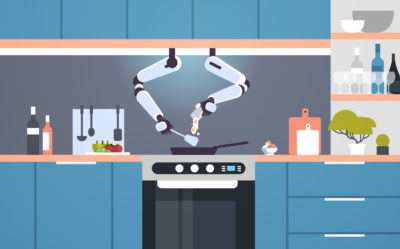With the explosion of ghost, host, and virtual kitchens far and wide, there’s one thing that’s clear … technology is reshaping how restaurant kitchens operate. It’s not just about taking your brand into the virtual world to expand your reach, it’s also about driving efficiencies into existing kitchens to control costs and reduce technology headaches.
A quick listen to Cody Jones, on Qu’s Restaurants Reinvented podcast, sheds light in this direction. Be it co-bots flipping our burgers or operators replacing gnarly tablet farms; the future is bright for tech savvy operators, says Cody.
As Qu’s senior product manager, tech wizard and self-avowed mad scientist Cody loves building things. When he found himself fighting with a cash register at the ripe age of 14, it ignited a life-long passion for building future-hardy restaurant technology.
“I’ve waited way too many tables in my day. But it does teach you a certain kind of empathy for those users,” Cody says.
He indeed he does have a deep understanding and empathy for all the stakeholders involved in the food experience at fast casual and QSRs. Through it all, he’s a firm believer in simplifying enterprise technology.
Cody is helping simplify restaurant tech stack by taking Qu’s digital-first POS one step further, into the kitchen, with an ultra-modern kitchen management platform, KitchenUP. This new technology simplifies what operators need to launch digital-centric kitchen concepts; like ghost, host, and other modern approaches.
“Nobody wants 10 tablets in their restaurants or kitchens, operators need simple and more resilient approaches. And the time has finally come to kill tablet farms once and for all.”
The KitchenUP product helps operators get new concepts spun up faster, and with a shorter learning curve using a one tablet and one menu approach.
Here are some of Cody’s other tips for modernizing your kitchen:
Use hardware products that are restaurant-tough
First and foremost, you don’t want to run your organization on a fire tablet – instead opt for something that’s restaurant-hardened, plugs into the wall, and that can’t be knocked off the counter with a slip of a drink. “Restaurant operators need resilient and simple solutions.”
Consider ghost, host, and virtual concepts
Host kitchens are having a moment right now, due to their potential to help brands innovate while simultaneously keeping communities up and running. However, Cody also acknowledges the tech and financial challenges faced by host kitchens.
Fortunately, new kitchen management solutions like those provided by Qu focus on streamlining and improving current processes. Qu’s one tablet to rule them all and one menu management platform enables operators to focus on innovating their food and brand, not fixing their tech. Qu has partnered with Franklin Junction to bring these solutions to the market faster.
Look for efficiencies at every turn
New technologies like cobots and touchless tech will enable more efficient kitchen operations. Consider Elo’s new contactless temperature readers to ensure safety in the kitchen. Cobots for flipping hamburgers and making fries are already being employed so brands can to use kitchen staff more efficiently.
“For years and years, we’ve all had the fear of: the robots are coming to steal our jobs. I really think the robots are here, but they’re ‘co-bots. They’re there to help us. … They’re not replacing your job. They can’t do everything a human can do, but they can do these repeatable tasks. To me, there’s a really cool intersection between these ghost and host kitchens and the robots and the technology that we provide that’s really going to enable kitchens of the future to get up there and just change the game.”
Cody is currently working on building Qu’s first touchless and gesture-based kitchen screen (“Minority Report” style), the KDS is currently in beta mode.
“There’s nothing worse than the kitchen ticket that falls into the marinara,” says Cody.
Tie together the whole restaurant tech stack
Every decision restaurant brands make should be based on actionable data. Cody advocates for tying together the tech stack to make data more accessible – that way the POS and digital offerings are fully aligned with marketing campaign mechanisms, such as offers and promotions; and teams can tie those things together and track them as a holistic organizational entity.
“The tools may be different but if all tied together in a uniform tech stack you can re-use data from other areas of the business.”
Hopeful about the changes that the COVID-19 pandemic has forced restaurants into, Cody believes new concepts and technologies will not only drive revenue but change different facets of the restaurant industry, including employee safety. Data and marketing are important aspects of even more changes on the horizon.
Look into the future of restaurant tech
Cody has big hopes for the future of the industry and believes the pandemic has sped up long-awaited changes in restaurant technology. What’s important, he says, is that those changes will make lives easier and better.
“We’re at this real intersection of the needs that are popping up due to this unprecedented time we live in, and it’s really a great time to be in the space. I couldn’t be happier to be building tech right now,” he says.


